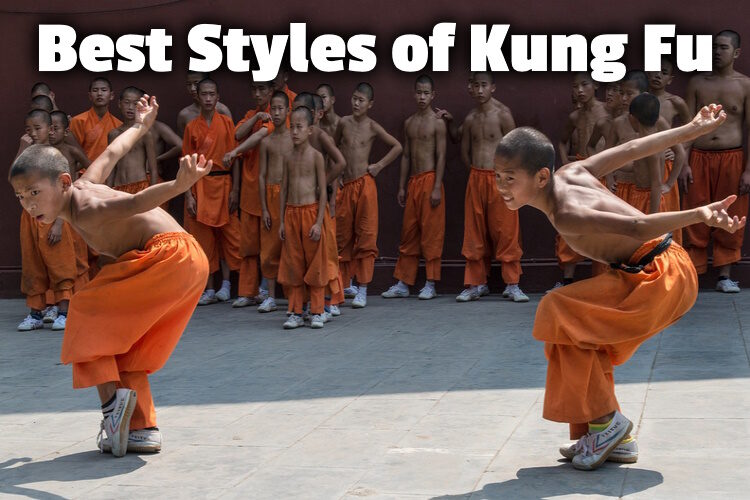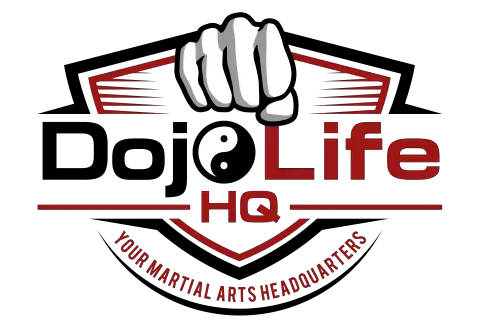Kung Fu is the name for ALL forms and styles of Chinese martial arts. As such there are hundreds of different styles of Kung Fu to choose from. But what is the best Kung Fu style?
The overall best Kung Fu style for self-defense is Wing Chun which is what Bruce Lee initially practiced. Wing Chun is fast-moving, powerful, and intense. But for flexibility, mobility, and improving mindset, Tai Chi is the best style.
But there are so many Kung Fu styles to choose from it’s not really fair to narrow it down to just two.
Some may be complex, and others are easy. So in this article, we’re focused on exploring 15 of the best styles of Kung Fu to choose from. That way you can find the one that most closely resonates with your goals.
Read on for more information on the best Kung Fu martial arts styles.

So what are the . . .
15 Best Styles of Kung Fu?
1. Shaolin Kung Fu
Shaolin Kung Fu is also referred to as Shaolin wushu or Shaolin Quan. It was liberated from the Shaolin temple atop Mount Songshan in Dengfeng County, Henan Province.
Both within and outside of China, it is well known. Shaolin Kungfu is infused with Zen Buddhist knowledge from the Buddhist monks, creating a variety of sub-styles.
This style of Shaolin kung fu includes wide stances and other stances like the horse, bow, crane, cat, back, dragon, and box, among others. In addition, there are kicks, spins, and jumps.
2. Wing Chun
Wing Chun is a close-quarters self-defense technique, a concept-based fighting style, and a variety of southern Chinese kung fu.
Ip Man (sometimes called Yip Man), who is regarded as the founder of contemporary Wing Chun, introduced the martial art from China to Hong Kong and ultimately the rest of the globe in 1949.
Bruce Lee, who studied under Yip Man before relocating to the United States, is probably his most well-known pupil. Jackie chan is also very skilled in this martial art.
It’s crucial to remember that simplicity is the basic tenet of Kung Fu. In the Wing Chun style, the concept of intricate movements and methods is ineffective; instead, soft techniques are adopted.
3. Baguazhang
One of the three primary Chinese martial arts of the Wudang school is Baguazhang, also known as Pakua Chang.
Dong Haichuan is credited with developing Baguazhang as a recognized martial art. He is reported to have studied with Taoist and Buddhist instructors in the early 19th century in the mountains of rural China.
This Kung Fu style of Chinese martial arts is characterized by slow movements, and it involves the interplay between the mind and its environment.
4. Tai Chi
Tai Chi is a Chinese form of exercise or attack and defense that is popular in all parts of China and throughout the world.
Tai Chi Chuan is a form of exercise that combines relaxation with bodily conditioning. It is based on the Taiji concepts, particularly the balancing of the yin and yang, or passive and active principles, respectively.
Tai Chi Chuan practitioners also move their bodies slowly and gently to strengthen their internal power. However, it can be practiced with the use of weapons.
Tai Chi requires agility and proper movement of the body, and the right shoes are essential!
In a recent article, I gave an insight into Tai Chi shoes and what is best to wear for practice. Many martial arts are practiced barefoot. But can you ever do that with Tai Chi?
Click on the link to read and find out on my site.
5. Xing Yi Quan
One of the internal styles of Chinese martial arts is Xing Yi Quan. It calls for explosive power, unpredictable movement, internal strength, and aggressive combat techniques.
A Xing Yi practitioner attacks and defends while simultaneously generating bursts of strength to overwhelm the adversary.
Ma Xueli of Henan Province and Dai Long Bang of Shanxi Province is credited with creating the oldest recorded accounts of Xing Yi, which date back to the 18th century.
Krav Maga and Kung Fu are both strong and well-known martial arts.
In a recent article, I wrote a detailed comparison, answering the question, “can Krav Maga beat Kung Fu?” I get into how the two styles are similar as well as key differences. But also whether one is stronger than the other for self-defense.
Just click that link to read it on my site.
Praying Mantis Kung Fu Grandmaster Ravi Chandran pic.twitter.com/ufDOK7FYT8
— Ravi Chandran (@RaviCha97766217) July 4, 2019
6. Praying Mantis
It was developed by Wang Lang and was given the name praying mantis in honor of the aggressive nature of the bug that served as its inspiration.
The fighting technique uses whip-like or circular motions to parry direct blows before launching precise blows at the opponent’s crucial points.
The Praying Mantis style involves northern styles and the adoption of the praying mantis, which is particularly renowned for its speed and constant attacks. Wrist/arm skills, as well as knee and elbow strikes, are particularly stressed.
7. Choi Lai Fut
Chan Heung founded the Chinese martial art and Wushu style of Choy Lai Fut in 1836. Choy Li Fut was given the name in honor of Choy Fook, a Buddhist monk.
In addition to the potent arm and hand techniques from the Shaolin animal styles, the system incorporates different fighting styles from various Northern and Southern Chinese kung fu systems.
It is regarded as an external style since it combines soft and hard techniques and includes a variety of weapons in its curriculum. Many different methods are included, including long- and short-range punches, kicks, sweeps, takedowns, and joint locks.
8. Nan Quan
The Southern Shaolin boxing style, known as Nan Quan, often referred to as the Nanfang Quan, is a fusion of Hung Gar, Mok Gar, and Choy Li Fut.
Nan Quan strongly emphasizes precise movements, quick hand changes, and solid footwork. But, when practicing Nan Quan, postures and strikes are paramount.
Kung fu is exciting, giving you the urge to learn. But if you don’t have a school near you, can you learn it at home?
If you are curious about the possibility of learning Kung Fu at home, I wrote about it in a recent article of mine. In the article, you will find out if learning Kung Fu at home is possible through YouTube videos or online classes. But can you earn a black belt that way?
Just click that link to read it on my site.
9. Chang Quan
Zhao Kuangyin, the first Emperor of the Song Dynasty, invented the fundamentals of Changquan/Long Fist) in the tenth century (960–1279). His method was known as Taiz Chángquán, which translates to “the Emperor Taizu Long Fist Technique.”
Various Chinese martial art systems are combined in the family of external martial arts known as Chang Quan. It emphasizes striking skills and fully extended kicks.
Chang Quan is practiced in modern times and is often displayed in various martial arts contests.
10. Bajiquan
Bajiquan was originally known as bazi quan, or “rake fist,” since the fists were used to strike downward in a rake-like motion while being held loosely and somewhat open.
The name was altered to Bajiquan because it was considered excessively vulgar in its native tongue.
In Cangzhou County, HeiBei Province, Hui Minority Kung Fu gave birth to baijiquan. With its explosive, close-range power tactics and intimate ties to the military system, Bajiquan is a potent kind of Kung Fu. Bajiquan is a popular martial art among politicians’ bodyguards.
11. Hung Gar
Hung Gar is a southern Chinese martial art that is part of the Shaolin southern schools. Strong stances, such as the horse stance, or “si ping ma,” and strong hand techniques, such as the bridge hand and the adaptable tiger claw, are characteristics of Hung Ga.
Even if the practitioner progresses gradually toward an inward focus, Hung Ga is sometimes mischaracterized as being only external—that is, dependent on the power of will rather than the cultivation of qi.
Kung Fu and Karate look alike and differentiating them might be challenging.
I have taken the time to write and show you the difference between Kung Fu and Karate in a recent article. But did one derive from the other?
Click the link to read the differences on my website.
Mmh, it looks like(?) they both shares the same Kung Fu animal style; the Tiger! (Heihuquan – Black Tiger Fist) pic.twitter.com/rnWiMKEFBf
— Souriel | Play Dragon’s Dogma! (@ZaSouru) June 14, 2018
12. Heihuquan
Although the style was initially developed at the Shaolin Monastery in Henan before being passed to Wang Zhenyuan, the system’s traditional lineage begins with him in the late nineteenth century.
Acrobatic kicks, wide, low stances, and a distinctive fist position in which the thumb is curled like the other fingers rather than twisted around are all characteristics of the Black Tiger style.
Nonetheless, the longer the stylist practices, the more they learn to rely entirely on the internal force. Martial artists feel the style is the most external in the Shaolin canon.
13. Hou Quan
Monkey Kung Fu, also known as Hóu Quán or “monkey fist,” is a Chinese martial art that uses moves that resemble those of apes or monkeys. Some Monkey Kung Fu techniques are used in northern Chinese martial arts like Northern Praying Mantis and Wuzuquan.
Running on all fours with hands and feet, performing challenging acrobatic maneuvers like sideways flips, front flips, back flip, back handsprings, handstands, walking on hands, forward lunges/dives, backward lunges, spinning on the butt, spinning on the back.
Various kicks and strikes are all part of traditional Hou quan as it is taught in mainland China.
14. Eagle Claw
A Chinese martial art known as Eagle Claw represents Chin Na, or Chinese grappling, and is renowned for its pressure point attacks, joint locks, and gripping maneuvers.
Even though the history of the eagle claw is contradictory, it can be said that it originated in Chinese military training and the Shaolin Temple.
It later developed into a family tradition passed down from generation to generation and eventually lost its air of secrecy with public martial arts schools opening.
15. Shuai Jiao
The name “jao di,” derived from the earliest Chinese phrase for wrestling, refers to an earlier kind of military Kung-Fu in which troops used horned headgear to butt, throw, and subdue their adversaries.
It can refer to numerous forms of wrestling played as either a sport or a martial art in China. When China was a republic (1912-1949), the art was brought to Southern China.
Conclusion
There are several Kung fu Chinese martial arts, and in this article, I have listed 15 unique and exciting Kung Fu styles from both the northern and southern styles of martial arts.
The best styles of Kung Fu are Wing Chun and Tai Chi Chuan.
Today’s martial artists like Jackie chan and Jet Li are skilled in more than just one Kung Fu style, which they use in Kung Fu movies to entertain us.
Image by Manfred Bieser from Pixabay
